Agronomy Update: Were You Impacted By The Freeze Event?
BY DAIRYLAND SEED AGRONOMY TEAM
New Seeding Alfalfa Cold/Frost Tolerance
As most alfalfa producers may have previously experienced, frost can nip some leaves on an established stand, and if the temperatures are below 26°F for a few hours, this may impact stems. If stems are affected on established plants, they will have regrowth coming from the crown buds, at the base of the plant.
New seedling Alfalfa much like an established stand can handle cooler temperatures of about 26°F, however four hours or more at these temperatures can kill these seedlings. This cold tolerance in new seedlings declines rapidly when the plant reaches the 2nd trifoliate leaf stage (two fully developed trifoliate leaves). Once these seedlings develop a more robust crown and root system, they will again be more cold/frost tolerant.
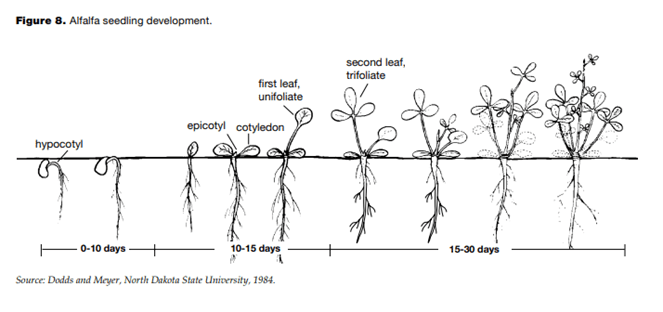
As always, if you have questions regarding this or other Agronomic topics, please contact your local Dairyland Seed Agronomist.
POOR STANDS: Leave Alone, INTER-PLANT/Patch or Tear Up & Start Over?
It Makes Your Head Hurt!
One of the most difficult decisions to make for agronomists and growers is what to do with fields with poor stands. First and foremost, try to rule out the emotional aspect of managing fields with less than ideal stands. Many factors come in to play when assessing the best thing to do. Leave it alone, inter-plant or patch in, or tear it up and start over are the decisions to be considered when stands are poor. Decisions should be based on facts -not emotions. Of course, many of these types of decisions depend on the calendar.
Facts needed to make wise economic decisions on what to do with poor stands should include the population of healthy plants and consistency of the stand throughout the field, original calendar date of planting and the percent of yield estimates for that date. Also, percent of yield based on the replant date that can be expected if you start over.
In 2018 we conducted a simulated corn and soybean replant study at Dairyland Seed’s Research Farm in Wabash, Indiana. The research project shows the response to multiple management scenarios for managing poor stands for 2018 in Wabash, Indiana.
Corn simulated replant study:
- Original planting date, 4/28/18 at 33,600k
- Treatment #1 (Full pop. 33,600k, planted 4/28/18)
- Treatment #2 (Thin stand at 22,000k, planted 4/28/18) Leave alone as is
- Treatment #3 (Inter-planting 18,000k into 22,000k stand 5/15/18) 2” to the side of existing rows
- Treatment #4 (Tear up/start over, later planting 5/15/18 @ 33,600k)
- Replicated 6 times
|
Hybrid |
Treatment |
Yield bu./ac. Average |
|
|
DS-6008 |
#1 |
Full pop |
250.6 |
|
DS-6008 |
#2 |
2/3 pop |
219.4 |
|
DS-6008 |
#3 |
Inter-plant |
226.1 |
|
DS-6008 |
#4 |
Delayed |
260.1 |
|
|
|
||
|
DS-9510RA |
#1 |
Full pop |
246.3 |
|
DS-9510RA |
#2 |
2/3 pop |
202.3 |
|
DS-9510RA |
#3 |
Inter-plant |
205.4 |
|
DS-9510RA |
#4 |
Delayed |
241.1 |
Soybean simulated replant study:
- Original Planting date, 140,000k, 5/10/18, 30” rows
- Treatment #1 (Full pop. 140,000k, planted 5/10/18)
- Treatment #2 (Thin stand 90,000K planted 5/10/18) leave alone as is
- Treatment #3 (Inter-planting 80,000k into 90,000k 5/25/18) 2” from existing rows
- Treatment #4 (Tear up/start over, later planting 5/25/18 @160,000k)
- Replicated 10 times
- DSR-3434/R2Y is the variety used in trial
|
Yield (bu./ac.) |
||||
|
Rep |
#1 |
#2 |
#3 |
#4 |
|
1 |
56.5 |
61.5 |
57.7 |
47.2 |
|
2 |
62.1 |
68.5 |
68.0 |
53.4 |
|
3 |
49.8 |
51.6 |
50.5 |
50.3 |
|
4 |
72.1 |
65.8 |
61.7 |
54.3 |
|
5 |
53.6 |
58.6 |
60.3 |
57.8 |
|
6 |
62.1 |
60.9 |
59.2 |
58.8 |
|
7 |
72.4 |
75.3 |
68.8 |
62.9 |
|
8 |
74.1 |
75.9 |
69.8 |
64.3 |
|
9 |
77.5 |
71.2 |
69.0 |
66.7 |
|
10 |
79.4 |
72.5 |
72.5 |
70.5 |
|
Average |
66.0 |
66.2 |
63.8 |
58.6 |
Cold Weather Update
The remainder of this week’s newsletter is filled with air and soil temperature data from around the Midwest. Hourly information, when available, is presented here. Daily averages are included for a few other places around the Midwest. Not only do we see the influences of geographic location, but also soil type. Sandy soils contain more air than other types, so you will note high daily soil temp swings.
Main takeaways:
- North and north central Michigan are the cold spots with eastern North Dakota not far behind.
- Sun makes a huge difference, often elevating soil temps far past daytime highs (note May 8).
- The morning of Saturday, May 9, was the low for many places. Closely watch crops that were out of the ground by then or had just been planted on Friday. Emerged crops can handle a few hours of air temps in the 28-32° range. Seeds just planted do best when they soak in water that is over 50° for the first 24-48 hours. When soil temperatures are below 50°, soil moisture, duration and timing determine whether cold imbibition damage becomes a factor.
- Overall, soil temps held okay, especially if we look at daily averages. Drier conditions leading into this cold snap will also help reduce stress from the cold.
Data Sources:
https://mrcc.illinois.edu/gismaps/networkvariables.htm, https://mawn.geo.msu.edu/, https://climate.sdstate.edu/archive, https://www.isws.illinois.edu/, https://sroc.cfans.umn.edu/, https://ndawn.ndsu.nodak.edu/
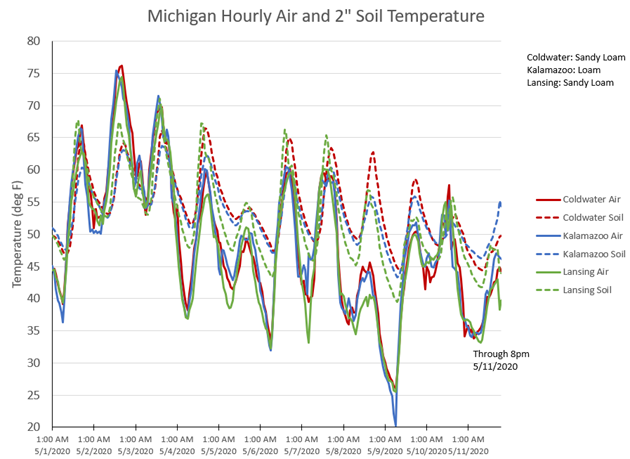
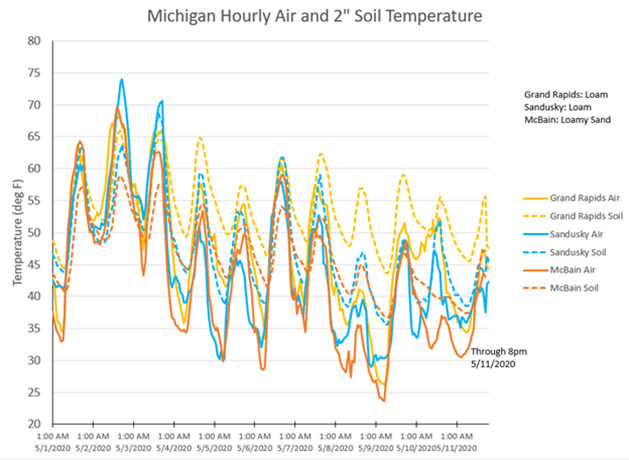
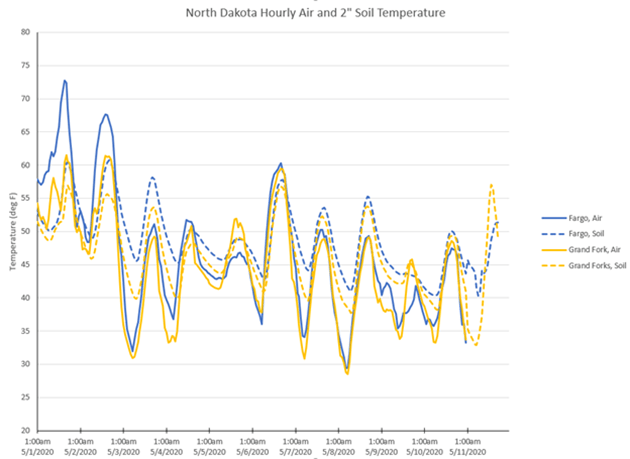
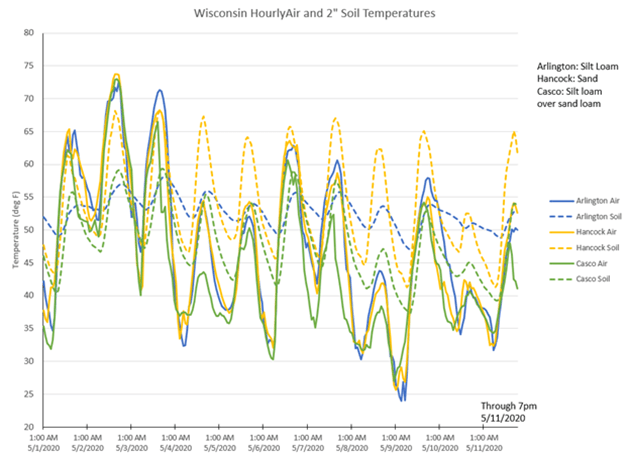
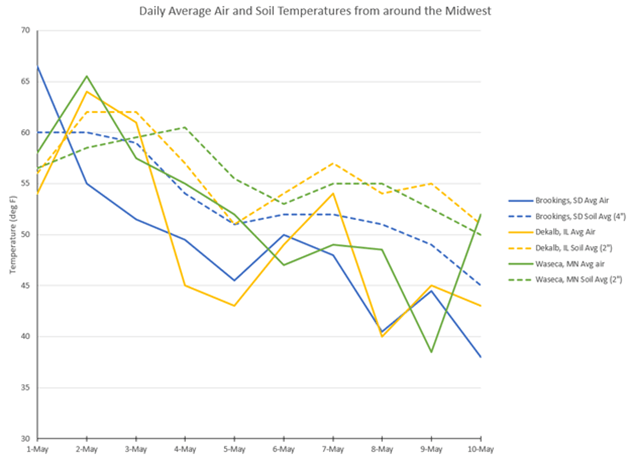
Corteva Technology Use Agreements
All growers with orders for any Corteva Agriscience brand seed product, regardless of crop or trait (including non-GM products) need to have a signed Corteva Technology Use Agreement in place by September 1. Growers should sign the Corteva Technology Use Agreement electronically at www.agcelerate.com. Signing electronically is preferable, however, paper copies are available at www.traitstewardship.com.
 |
 |
 |
 |
 |
| Brian Weller Western Region 507.456.3034 |
Dan Ritter Central Region 219.863.0583 |
Branden Furseth Northern Region 608.513.4265 |
Rod King Eastern Region 574.596.6721 |
Terry Jones Eastern Region 419.630.3115 |
